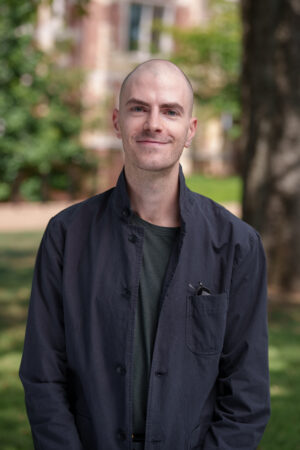New faculty Q&A: How media organize the world around us with Sasha Crawford-Holland
 Meet new Assistant Professor of Cinema and Media Arts Sasha Crawford-Holland and learn about his research on media and the environment, what excites him about teaching, and what he is looking forward to in joining the College of Arts and Science this fall.
Meet new Assistant Professor of Cinema and Media Arts Sasha Crawford-Holland and learn about his research on media and the environment, what excites him about teaching, and what he is looking forward to in joining the College of Arts and Science this fall.
Q: What is your area of research and teaching?
A: Increasingly, people are paying attention to the ways that data, surveillance, and artificial intelligence have dramatic implications for various groups of marginalized people: how they exacerbate inequality, but at the same time, how they can be used to redress certain inequalities. This is generally the domain of negotiation or struggle that we think about in my classes. By deploying the tools of media studies, we think about how media organize the world around us, but also how people can use skills in media critique and media production to transform those power relations. My own research zooms in on this question in the context of environmental issues and environmental activism. Using the tools and techniques of media studies, we can analyze the political implications of how our perceptual worlds are configured. My current project is concerned with the politics of temperature. How is it that media organize our understanding of how temperature works and our actual sensory experiences of heat? For example, we could think about our experience of a heat wave and analyze how the way that it’s covered by local news versus a weather app versus a website is going to shape our experience of how that heat wave feels and who is made most vulnerable to it.
Q: What excites you most about teaching?
A: One of my favorite things about teaching media studies is that because everyone has these experiences, I’m less focused on conveying specific content to students than on equipping them with the analytical and descriptive tools to substantiate their insights. We use media studies to understand, why did I respond to a film or social media post in that way? And what are the implications of it? I see my role as equipping students to offer their own responses to that question in ways that are robust and defensible, rather than telling them what the takeaway should be. Two areas in which I’m going to be teaching are environmental politics and digital media. These topics are changing very quickly, both within and beyond academia, and have severe political and social implications. No matter what students go on to do after college, their lives will be completely impacted by whatever our digital and environmental futures end up looking like. It’s incredibly exciting to me to create a space for conversations about these issues and to prepare students to understand and participate in shaping those futures.
Q: What excites you most about joining the College of Arts and Science?
A: I’m really excited to be teaching in two departments, cinema and media arts and in communication studies, both of which train students in both critical and practice-based approaches. To be in these disciplinary homes where the work that students are doing is moving very seamlessly between those two domains is both energizing and exciting. I also think it lends itself to a more intellectually rigorous experience where you don’t have that divide between the theoretical discussions and their real-world implications.
